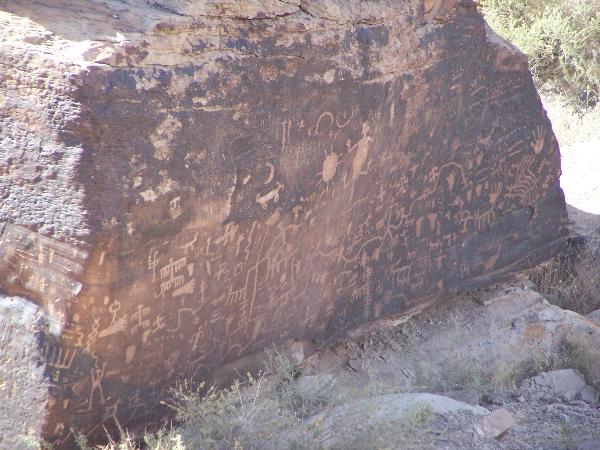
 Desert Varnish
Desert Varnish
The petroglyphs of Newspaper Rock are etched into dark desert varnish to expose the lighter color of the rock beneath.
Desert Varnish is made up of a thin veneer of manganese, iron and clay that covers the exposed surfaces of the rocks. According to the prevailing theory (by Ronald I. Dorn and Theodore M. Oberlander) proposed in 1981, desert varnish is created by microscopic bacteria over thousands of years.
 The bacteria oxidize the tiny amounts of manganese and iron in the atmosphere to obtain energy. After the bacteria oxidize the manganese and iron, it deposits the manganese oxide or iron oxide on the surface of the rock as the black or reddish coating you see. Clay particles, probably obtained by wind are also included in the varnish and likely help protect the bacteria from drying out and solar radiation. It is thought that it could take as much as 10,000 years for a mature desert varnish to form on these desert rocks.
The bacteria oxidize the tiny amounts of manganese and iron in the atmosphere to obtain energy. After the bacteria oxidize the manganese and iron, it deposits the manganese oxide or iron oxide on the surface of the rock as the black or reddish coating you see. Clay particles, probably obtained by wind are also included in the varnish and likely help protect the bacteria from drying out and solar radiation. It is thought that it could take as much as 10,000 years for a mature desert varnish to form on these desert rocks.
However, the complete mechanisms and processes that create desert varnishes have not been fully explained. Recent research and past works continue to propose alternate mechanisms for its formation and explain all the complexities of its formation. Some of these other theories include a completely inorganic source, mineralization of microbe spores after they begin to break down, photochemical (sun driven chemical reactions), and silicic acid (fromed from quartz or silica).
A much referenced work on the subject is Dorn, R.I. and T.M. Oberlander. 1981. "Microbial Origin of Desert Varnish." Science 213: 1245-1247 (but I was unable to locate for this earthcache).
Cliff Retreat
The rock that makes up the mesa you are standing on is the Newspaper Rock Sandstone. While this rock appears quite stable, it is highly fractured. Beneath the sandstone are mudstones that erode away easily. As the mudstone erodes out from beneath the sandstone, the fractures in the sandstone begin to widen as the block of sandstone slowly begins to fall out from the cliff. Eventually, the sandstone block will fall down the cliff. The trail down to Newspaper Rock was destroyed in 1984 by such a process.
Logging requirements:
Send me a note with :
- The text "GCZCNM Newspaper Rock Desert Varnish" on the first line
- The number of people in your group.
- Provide a short explanation as to why the recently exposed rocks are not as dark as the boulders that have the petroglyphs
The above information was compiled from the following sources:
- Bezy, John V. and Arthur S. Trevena, 2000, Guide to Geologic Features at Petrified Forest National Park, Arizona Geological Survey Down-to-Earth 10
- Woody, Daniel T., 2006, Revised Stratigraphy of the Lower Chinle Formation (Upper Triassic) of Petrified Forest National Park, Arizona, in A Century of Research at Petrifed Forest National Park, Museum of Northern Arizona Bulletin No. 62, Parker, W.G., Ash, S.R, and Irmis, R.B., eds., 2006
- Ash, S.R. 1987, Petrified Forest National Park, Arizona, Geological Society of America Centennial Field Guide – Rocky Mountain Section, 1987
- Anza Borrego Dessert State Park 2003, Nature Trail Guide, Palm Canyon Trail
- Wayne P. Armstrong, Desert Varnish & Lichen Crust Microscopic Organisms Color Rocks & Boulders, http://waynesword.palomar.edu/pljan98.htm
- Randall S. Perry and Vera M. Kolb, undated Biological and organic constituents of desert varnish: review and new hypotheses, pdf from http://www.psi.edu/~rperry/perry/ SPIE_DV.pdf
Placement approved by the
Petrified Forest National Park